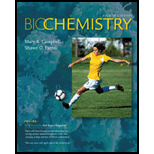
Concept explainers
REFLECT AND APPLY (a) The major energy storage compound of animals is fats (except in muscles). Why would this be advantageous? (b) Why don’t plants use fats/oils as their major energy storage compound?
Interpretation:
The following concept is to be explained
Concept introduction:
The catabolic breakdown of carbohydrates is an aerobic and anaerobic process. There are carbohydrate polymers, such as starch in plants and glycogen in animals, which represent stored energy of the body. These carbohydrates can be hydrolyzed to monomers and then oxidized to provide energy in response to the needs of an organism.
Answer to Problem 1RE
Solution:
Animals use fat as a major store compound for energy. Energy is released when bonds that hold together the molecules in food are broken.
Plants get energy from the sun to break the molecules of water and air during the process of photosynthesis.
Explanation of Solution
Animals use fats/oils as a major energy storage component.
Fats are an important micronutrient for animals. It is a dense source of energy that helps to keep animals active and energetic. It is stored in the body cell and burns itself while doing any strenuous work to provide energy and stamina. Triglycerides is the essential body fat. Since, unlike plants, animals are mobilized, they need high energy for running, flying, catching prey, and other activities. So, the requirement of the energy for such activities is fulfilled by the breaking down of fats in the animal body.
Plants do not use fats/oils as a major energy storage component.
Plants exhibit the process of photosynthesis for the formation of glucose and oxygen from carbon dioxide and water in the presence of sunlight. The excess of glucose in stores in plants, in the form of starch, is the same as glycogen stored in a human body. The breaking of fats in a body is a complex process and not energetically favored. Plants body cannot perform this process as they do not have an enzyme that are required for the breaking or the emulsifying of fats/oils in their body.
Want to see more full solutions like this?
Chapter 21 Solutions
Biochemistry
- REFLECT AND APPLY Why is it better, when running a marathon, to drink a beverage with sugar for energy rather than one with amino acids?arrow_forwardREFLECT AND APPLY How is it advantageous for animals to convert ingested starch to glucose and then to incorporate the glucose into glycogen?arrow_forwardREFLECT AND APPLY In Section 2-4, we said that at the equivalence point of a titration of acetic acid, essentially all the acid has been converted to acetate ion. Why do we not say that all the acetic acid has been converted to acetate ion?arrow_forward
- REFLECT AND APPLY Would nature rely on the same enzyme to catalyze a reaction either way (forward or backward) if the DG were 0.8kcalmol1? If it were 5.3kcalmol1?arrow_forwardREFLECT AND APPLY What is the energy cost per amino acid in prokaryotic protein synthesis? Relate this to low entropy.arrow_forwardREFLECT AND APPLY Why is it somewhat misleading to study bio- chemical pathways separately?arrow_forward
- REFLECT AND APPLY Why do most mammals, other than primates, not suffer from gout?arrow_forwardREFLECT AND APPLY You are studying with a friend who is describing the Bohr effect. She tells you that in the lungs, hemoglobin binds oxygen and releases hydrogen ion; as a result, the pH in- creases. She goes on to say that in actively metabolizing muscle tissue, hemoglobin releases oxygen and binds hydrogen ion and, as a result, the pH decreases. Do you agree with her reasoning? Why or why not?arrow_forwardREFLECT AND APPLY Other things being equal, what is a potential disadvantage of an enzyme having a very high affinity for its substrate?arrow_forward
 BiochemistryBiochemistryISBN:9781305961135Author:Mary K. Campbell, Shawn O. Farrell, Owen M. McDougalPublisher:Cengage Learning
BiochemistryBiochemistryISBN:9781305961135Author:Mary K. Campbell, Shawn O. Farrell, Owen M. McDougalPublisher:Cengage Learning
